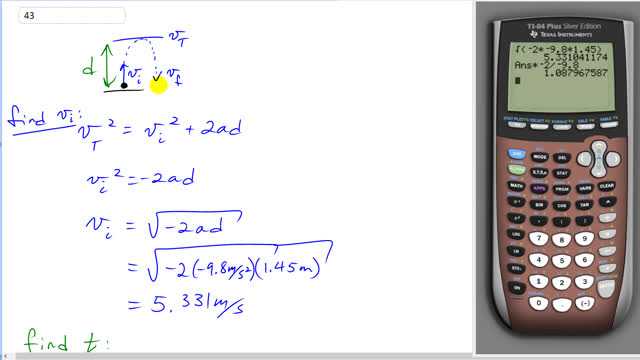
A kangaroo jumps straight up to a vertical height of 1.45 m. How long was it in the air before returning to Earth?

In order to watch this solution you need to have a subscription.
This is Giancoli Answers with Mr. Dychko. The kangaroo jumps up with an initial velocity that we'll have to find and then reaches some maximum height d that we are given and then returns back down and when the kangaroo just reaches the ground, it has a velocity downwards of equal magnitude to its velocity upwards just opposite direction. So we'll say that final velocity is the negative of the initial velocity for the kangaroo. But first of all, let's figure out what this initial velocity is and we'll use this formula and the final velocity at the very top is zero so v top squared equals v initial squared plus 2ad and we'll subtract 2ad from both sides and switch the sides around so we have initial velocity squared equals negative 2ad take the square root of both sides and we have initial velocity is square root of negative 2 times acceleration times the height that it reaches. So that's square root of 2 times negative 2 times negative 9.8 times 1.45 meters height which is an initial launch velocity of 5.331 meters per second. And then we'll use this formula to find the time that it spends in the air knowing that initial velocity is negative of the final velocity and then we'll substitute for final velocity and write negative of initial velocity in its place and then subtract v i from both sides giving us negative 2v i on the left and then switch the sides around and divide by a to solve for t. So t is negative of 2 times initial velocity divided by a so that's negative 2 times 5.331 meters per second divided by negative 9.8 meters per second squared and so the kangaroo spends 1.09 seconds in the air.
Why vi=vf
Hi joseotilio25, there are a couple ways to answer that. First answer: when something launched upward returns back to it's original height, it will have the same speed it was launched with. Second answer: in the stands for displacement, which is zero when the projectile returns to its original height. This means the equation reduces to . After taking the square root of both sides, .
Cheers,
Mr. Dychko